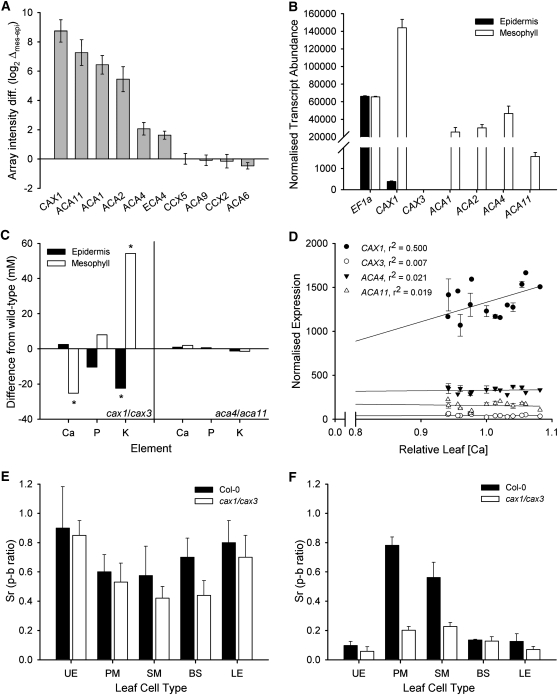Figure 2.
Identification of Candidate Transporters Underscoring Preferential Accumulation of Ca in the Mesophyll by Comparing Arabidopsis Epidermal and Mesophyll Transcriptomes Using SiCSA/Microarray and qPCR.
Mesophyll accumulation of Ca (Sr) is a dominant factor in total leaf Ca accumulation, and CAX transporters play the key role in both mesophyll preferential and total leaf Ca accumulation. Sr accumulates in the apoplast of all cell types and yet preferentially in the mesophyll of Col-0 and cax1/cax3 plants.
(A) Microarray-based screen of comparative expression for Ca2+-ATPase (ACA/ECA) and Ca2+/H+ exchanger (CAX and CCX) families within palisade mesophyll and adaxial epidermal cells of 5-week-old Arabidopsis KC464 line grown hydroponically in BNS. Data are presented as the log2 difference between the mean intensity ± se for each gene in the palisade mesophyll minus that for the adaxial epidermis. Data are derived from three epidermal and three mesophyll samples taken from three plants (refer to Methods for array details and labeling). For extended data set, see Supplemental Table 3 online.
(B) qPCR confirmation of preferential expression of Ca2+ transporters within palisade mesophyll cells. aRNA from Arabidopsis KC464 line isolated by SiCSA was normalized using Elongation Factor 1α (EF1α) and β-tubulin 5 (see Supplemental Figure 2C online), while for EF1α transcript abundance, normalization was performed against β-tubulin 5. Three amplifications were performed on three independent plants to those used in Figure 2A, with data presented as mean normalized expression levels + se. qPCR was performed in triplicate for each biological replicate.
(C) Difference in Ca, P, and K concentration in adaxial epidermal and palisade mesophyll cells between the Col-0 parent and T-DNA insertion lines aca4/aca11 and cax1/cax3. Six-week-old plants grown in BNS (1 mM aCa) were analyzed by SiCSA/XRMA analysis, with data presented as mean change in [Ca]vac compared with Col-0 (n = 25 cells across five plants). Asterisk indicates significant difference from Col-0; Student’s t test (P < 0.05).
(D) Correlation of ICP-MS and microarray data across 15 Arabidopsis ecotypes, reinforcing the importance of CAX1 in Ca accumulation. Normalized microarray data obtained from Lempe et al. (2005) and ICP data obtained from Purdue ionomics information management system database (Baxter et al., 2007) (www.ionomicshub.org), normalized using REML (Broadley et al., 2010) on leaves of plants grown in soil with the same fertilization and light regimens. Weight-normalized values (in ppm) were used and presented relative to Col-0 to facilitate interexperimental normalization of ICP data (mean ± se).
(E) and (F) Sr content was measured within excised leaf 8 from BNS-grown plants sampled at 6 weeks of age, fed with 50 mM SrCl2 through the petiole for 16 h in an artificial sap background (AS). p-b, peak over background ratio as defined by Storey and Leigh (2004). n = 4 cells per leaf 8, four separate plants (mean + se). For cell-type abbreviations, see Figure 1A. Despite no significant difference in apoplastic Ca surrounding all cells (E), mesophyll vacuoles (F) of cax1/cax3 leaves are inhibited in their ability to accumulate Sr (Ca) compared with Col-0.

